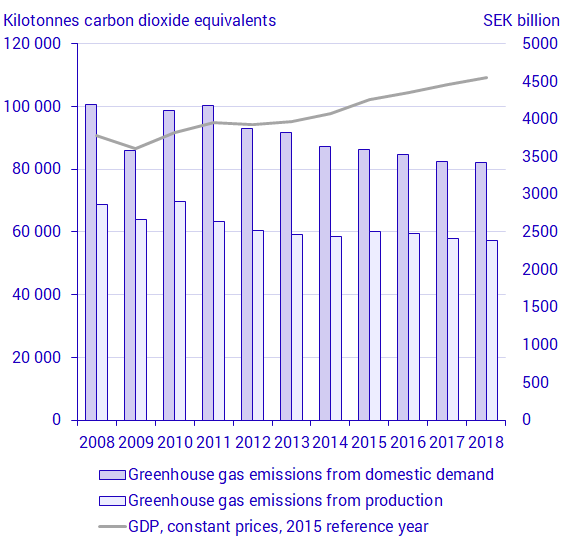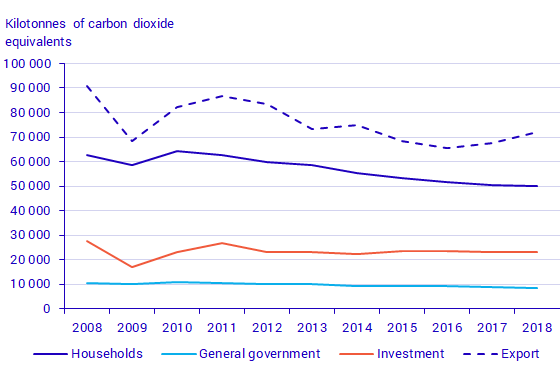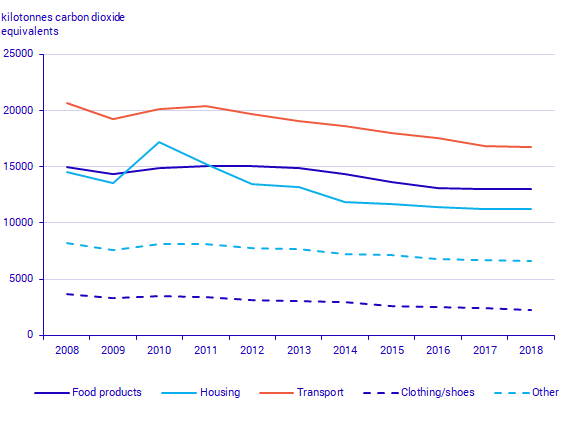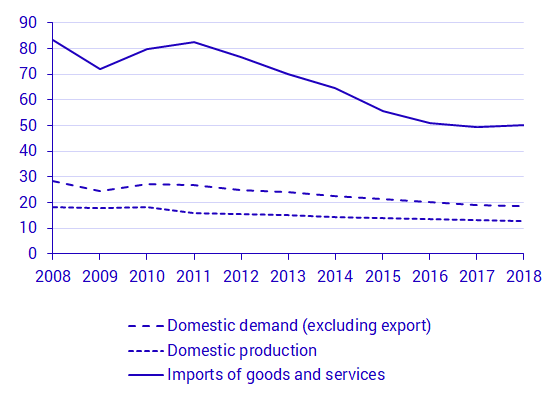Environmental accounts – environmental pressure from consumption 2018
Greenhouse gas emissions from domestic demand remained unchanged
Statistical news from Statistics Sweden 2020-11-19 9.30
Between 2017 and 2018, greenhouse gas emissions from domestic demand in Sweden’s economy remained relatively unchanged at about 8.1 tonnes of carbon dioxide equivalents per capita. Since 2008, emissions have decreased by 18 percent from 100 million tonnes of carbon dioxide equivalents to 82 million tonnes.
In 2018, greenhouse gas emissions from domestic final demand in Sweden’s economy amounted to 82 million tonnes of carbon dioxide equivalents, about 8.1 tonnes per capita. This is also called Sweden’s consumption-based emissions, covering domestic demand from households, the public sector and investments, but excluding exports. This is a decrease compared to 2008, when emissions were 100 million tonnes of carbon dioxide equivalents (10.9 tonnes per capita). The trend towards decreased emissions is due to declining emissions from Swedish production and decreasing emissions from Swedish imports. For this publication, adjustments have been made to the whole time series from 2008–2017 (see also below under revisions).

Source: Statistics Sweden
* Swedish domestic demand comprises household and general government consumption and investments and excludes exports.
** Time series break in 2015 (due to general review of national accounts).
Greenhouse gas emissions due to household consumption an important factor
Greenhouse gas emissions from households’ consumption amounted to nearly 50 million tonnes of carbon dioxide equivalents in 2018. This is 20 percent less than in 2008. Between 2017 and 2018 emissions remained relatively unchanged.
Swedish exports are also a significant driving force for greenhouse gas emissions. Emissions have also decreased here, from 91 million tonnes of carbon dioxide equivalents in 2008 to about 72 million tonnes in 2018. However, emissions from exports increased by 6 percent between 2017 and 2018.

Source: Statistics Sweden
*Time series break in 2015.
Note: Households also include non-profit institutions.
Trend towards lower emissions from household consumption in all areas
Between 2017 and 2018, greenhouse gas emissions from households remained relatively unchanged. However, between 2008 and 2018, emissions have decreased in all areas of household consumption, including food products, transport, housing, textiles, and shoes.

Source: Statistics Sweden
*Time series break in 2015.
A large proportion of products consumed by households were imported. These imports are responsible for a large proportion of greenhouse gas emissions. For example, over 60 percent of greenhouse gas emissions from household consumption of food products arise from directly imported food products and from products imported for use in the supply chain for food products.
Greenhouse gas emissions intensity for domestic demand decreasing
In 2018, the greenhouse gas emissions intensity for domestic demand in Sweden’s economy was 19 kg carbon dioxide equivalents/SEK 1000. This is 33 percent less than in 2008. In absolute terms, the drop in greenhouse gas emissions between 2008 and 2018 is, in fact, less, because the domestic demand in Sweden’s economy has also increased during this period.
The greenhouse gas emissions intensity for imported and domestic production in Sweden’s economy differ significantly. In 2018, the greenhouse gas emissions intensity for domestic production was 13 kg carbon dioxide equivalents/SEK 1000. In the same year, the intensity for imported production was 50 kg carbon dioxide equivalents/SEK 1000. Between 2008 and 2018, the greenhouse gas emissions intensity for domestic and imported production decreased by 31 percent and 41 percent respectively.
Greenhouse gas emission intensity, kg carbon dioxide equivalents per 1 000 SEK

Source: Statistics Sweden
*Time series break in 2015.
Revisions
For this publication, revisions have been implemented in source data used in statistics production. This leads to differences in the time series compared with earlier publications of this product.
Revisions in the National Accounts
For each yearly publication, revisions are made to the entire time series for the National Accounts statistics on production, intermediate use, final demand and foreign trade in Sweden’s economy. More information about the revisions can be found here:
Nationalräkenskaper 1993-2018 (pdf) (in Swedish)
Beyond yearly revision, the National Accounts carry out a more comprehensive general review every five years. The review covers input data, methods and calculation models in many areas. This was done most recently in 2019. More information about the result of this latest review can be found here:
However, the National Accounts have not revised data used to produce these statistics (detailed supply and use tables) according to the 2019 general review for reference years before 2015. Therefore, a time series break in the statistics published here arises between reference years 2014 and 2015 and comparisons should therefore be made with caution.
Revisions in input data on air emissions from domestic production
For the complete time series 2008-2018, a new method of residence adjustment has been implemented for the data on air emissions from domestic production that are used as input data for these statistics. This residence adjustment is applied to adjust statistical sources with a territorial perspective to the environmental accounts’ economic perspective. The new residency adjustment applies primarily to transport: heavy duty road transport (primarily within H49 land transport companies, but also other industries such as construction), water transport (H50) and air transport (H51). The new residency adjustment has led to a decrease in the calculated greenhouse gas emissions from Sweden’s economy by approximately three million tonnes of carbon dioxide equivalents per year.
Revisions in environmental pressures for imported goods and services
Statistics Sweden uses EXIOBASE, a global multi-regional input-output database, to estimate emissions arising due to Sweden’s imports. The database is developed and maintained by a consortium led by the Norwegian University of Science and Technology in Trondheim, Norway.
For the production year 2020, a new version of EXIOBASE was implemented – version 3.8. For production year 2019, EXIOBASE version 3.7 was used.
Updates in the latest version include:
- Macroeconomic and trade data for the most recent years
- Data on energy and energy-related emissions
- Sector allocation for energy and energy-related emissions
More information can be found in the following paper:
Definitions and explanations
These statistics form part of the environmental accounts. The Environmental Accounts are based on the National Accounts and present national environmental statistics and economic statistics in a common framework. Environmental data is systematised according to the same industry classification and areas for final use as economic data. The main goal of this systematisation is to analyse the relationship between economic and environmental performance.
The National Accounts measure gross domestic product in two different ways – from a supply perspective and from a demand perspective. The environmental accounts also measure the gross domestic product, but from an environmental perspective. Where the production perspective answers the question – “who is emitting?”, the consumption perspective answers the question “who benefits from the emissions?”
The method used to produce these statistics is based on environmentally extended input-output analysis, using the framework of the national accounts. This approach is based on the results of a recently completed research project, PRINCE (Policy Relevant Indicators for Consumption and Environment):
Statistics on environmental pressure from consumption present environmental pressure in relation to the macroeconomic balancing equation that is the basis for the national accounts. The equation for Sweden’s balance is
P +M = C + G +I+ E (equation 1)
in which P is Sweden’s GDP, M is total imports to Sweden, C is household consumption, G is general government consumption, I is gross capital formation, and E is total export to other countries from Sweden. In accordance with the system of national accounts, all variables are presented in monetary terms. The statistics presented in this publication show greenhouse gas and other air emissions for each term in the equation. For each term, the environmental pressure is allocated to over 40 different product groups.
For household consumption, environmental pressure is presented according to the international COICOP allocation (classification of individual consumption by purpose).
Relationship to other official emissions statistics
Starting with this publication, official statistics on greenhouse gas and other air emissions are presented from three complementary perspectives:
- From Sweden’s economy with a consumption perspective (these statistics)
- From Sweden’s economy with a production perspective
- From Sweden’s territory (territorial statistics)
Statistics Sweden is responsible for statistics with a production and consumption perspective as a part of the system of environmental economic accounts. Statistics with a consumption perspective are unique since they present environmental pressure for all goods and services that are produced and used in the Swedish economy along their entire production chain. This is particularly interesting for Sweden since a large proportion of goods and services that are used in the Swedish economy are imported. Sweden also exports a large proportion of the domestic production.
Environmental accounts’ official statistics from a production perspective present greenhouse gas and other air emissions from the Swedish economy’s total domestic production of goods and services, by sector. This system boundary represents the P term in Equation 1 above and includes Swedish economic actors’ environmental pressure irrespective of where in the world the pressure occurs.
The Swedish Environmental Protection Agency produces official territorial statistics, and presents those environmental pressures that occur within Sweden’s borders.
All of these statistics are included in Sweden’s official statistics and they follow uniform guidelines on when and how the statistics are published, quality assurance, and documentation.
Results differ between different official statistics
The different system boundaries that are applied in the production of statistics from the three different perspectives lead to differences in the absolute emissions levels as shown in the statistics. Air emissions from a production perspective include virtually all air emissions included in territorial statistics, as well as emissions from international transport operated by Swedish economic actors. Therefore, emissions from a production perspective are in practice greater than emissions from a territorial perspective, which exclude emissions from international transport.
Sweden’s imports and exports are almost exactly balanced, with exports being slightly greater. At the same time, the greenhouse gas emissions intensity (emissions per unit production in monetary terms) for domestic production is lower in Sweden than in Sweden’s major trading partners. This means that greenhouse gas emissions presented in statistics with a consumption perspective are larger than in statistics with a production perspective, even when emissions from Sweden’s export are excluded.
The different official statistics can also be used for different purposes. Statistics from environmental accounts can be used to support policy analyses from an economic and environmental perspective, or investment and procurement decisions.
Territorial statistics are used to follow the development of emissions in relation to climate change goals in Sweden, the European Union and the United Nations. These statistics show which emissions sources are present in the country. Countries therefore have significant jurisdiction over laws and regulations that can affect emissions and can easily perform calculations of national reduction targets.
More information about the different perspectives
Environmental accounts’ air emissions accounts
The Swedish Environmental Protection Agency and Statistics Sweden’s joint description of the statistics (in Swedish)
Glossary of selected terms
Household consumption
Consumption by households and private citizens. Includes non-profit institutions serving households (NPISH).
General government consumption
Consumption by state, county and municipal authorities.
Investments
Investments by general government and industry, for example procurement of machines, buildings and roads. Investments can be subdivided into gross fixed capital formation, changes in inventories and the net acquisition of valuables.
Export
Foreign actors’ use of goods and services arising from Swedish production.
Final consumption/demand/use
Terms used interchangeably for the sum of general government consumption, household consumption, investment and export. “Final” refers to the fact that it is not used in the production chain, rather it is the end of the production chain.
Component
A part of final use, for example for household consumption or export. Each component generates emissions in Sweden and abroad due to import for final use and imports to be used domestically for the production of other goods and services.
Emissions from consumption, consumption perspective
Emissions arising from the consumption of goods and services in Sweden and abroad due to imports.
Emissions from production, production perspective
Emissions arising from the production of goods and services in the economy.
Next publishing will be
The next publication of statistics on environmental pressures from consumption is scheduled for November 2021.
Statistical Database
More information is available in the Statistical Database
Feel free to use the facts from this statistical news but remember to state Source: Statistics Sweden.
